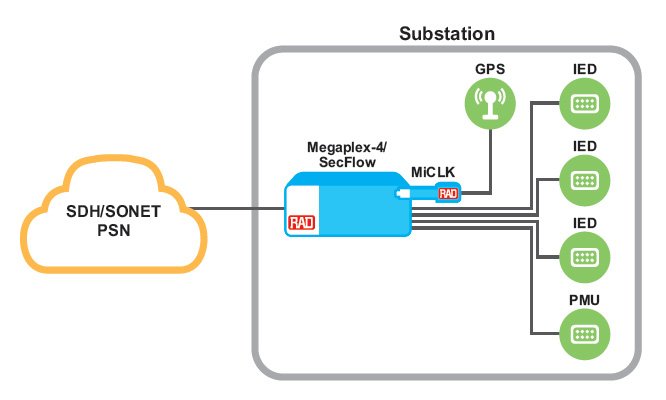Your Network's Edge®
Application Briefs
You are here
1588 Grandmaster on an SFP for Timing Synchronization in Power Utility Networks
Precision timing increases the efficiency and uptime of electric utilities by improving their monitoring and troubleshooting capabilities. IEEE C37.238- 2011 is rapidly becoming the global standard for power system automation, protection, control, and data communications over packet-switched networks. IEEE C37.238-2011, therefore, specifies IEEE 1588-2008, also known as PTPv2 (optimized for use in electric power industry network architectures) as the protocol to meet the synchronization requirements of most power systems applications. It is currently being considered for inclusion in IEC 61850 Edition 2.
IEEE 1588-2008 is a future-proof solution for power utilities because it meets timing accuracy needs for both today’s and tomorrow’s applications. Remarkably, it does so while reducing the cost of installing and maintaining a separate dedicated timing network (IRIG-B), since dedicated cabling for delivering synchronization to IEDs is no longer required. IEEE 1588, in contrast, transports timing synchronization information (packets) over the same cabling as data.
Protection and Control IEDs
Time syncronization is required for intelligent electronic devices (IEDs) to perform fault recording, sequence of events recording and any other functions that require information from IEDs to be time-stamped. When events and timing are recorded in the proper chronological order, pre-fault, fault and post-fault events can be accurately analyzed. Usually, protection and control IEDs have an internal clock resolution of 1ms. The typical requirement for time synchronization in IEC 61850 substation automation systems, however, is to guarantee 1ms time-stamping accuracy for the station bus and less then 1μs time-stamping accuracy for the process bus. With IEEE 1588-2008, this requirement can be achieved much more cost-effectively than it was using legacy IRIG-B solutions.
IEEE 1588-2008 and Phasor Calculation
Synchrophasors are devices that were developed to measure the state of the electrical power grid and manage power quality. Phasor measurement units (PMUs) evaluate electrical wave data at given locations in the power system (substations) and calculate a comparison of two values at different locations synchronized to absolute time. The IEEE C37.118 standard defines and determines communication between synchrophasors and how they should be time-stamped and defines timing accuracy in terms of microseconds. In a packet-switched network, the only solution for doing so is IEEE 1588 v2.
RAD’s Synchronization Solution for the Power Grid
RAD’s Service Assured Networking (SAN) solutions are ideal for upgrading IEDs and PMUs to the IEC 61850 standard, or when IEEE 1588-2008 is used for any other synchronization application. These SAN solutions are based on RAD’s innovative MiCLK, an SFP-based IEEE 1588 Grandmaster with a built-in GNSS receiver. The finger-sized MiCLK enables timing over packet (ToP) by instantly upgrading any existing substation network device to the IEC 61850 standard. This eliminates the need to install bulky, standalone GNSS (GPS/GLONASS/BeiDou) receivers at every substation site, reduces power consumption and operational costs and eliminates additional “points of failure” while providing highly accurate timing distribution for any network element requiring phase or Time of Day (ToD) synchronization.

Typical Users
Power utility substation automation
Typical Application
IEDs and PMU syncronization
Features
- IEEE 1588 Grandmaster with built-in GNSS receiver
- Highly accurate timing distribution
- Easy installation into RAD’s Megaplex-4, SecFlow or any other vendor’s multiservice platform
Benefits
- Eliminates the need for GNSS receivers at every substation site, reduces power consumption and operational costs and eliminates additional “points of failure”
- Instantly upgrades any existing substation network device to IEC 61850
- Provides GNSS time reference to all connected devices regardless of manufacturer
Related Products
The Megaplex-4’s ability to handle a broad range of Ethernet, data and voice services, as well as a large variety of network technologies, in a single compact managed node, makes it an ideal solution for carriers and service providers. The device also provides a perfect fit for large enterprises, utilities and transportation companies who require an efficient way to transport and provision multiple legacy and next-generation services over their high capacity pipes. Megaplex-4 can be used as a central aggregation unit for TDM and Ethernet CPEs that are connected over various access link technologies, e.g., HSDSL and SDH/SONET.
The Megaplex-4 is available with a cable management solution to reduce storage space and handling, and eliminate cable waste.
Easily plugged into service routers to simultaneously distribute frequency and time, the patented MiCLK eliminates the need to install GPS/GNSS antennas at every cell site while providing highly accurate timing distribution with full network coverage – even in underground and in-building installations. It is also ideal for 4G small-cell deployments. The field-proven MiCLK allows service providers to dramatically reduce installation and engineering costs by eliminating the need for additional space or power requirements.
The field-proven MiCLK allows service providers to avoid spoofing and jamming risks, and dramatically reduces installation and engineering costs by eliminating the need for additional space or power requirements.
SecFlow-1 is ideal for industrial IoT backhaul, enabling fast, secure and economical deployment of new IoT sites. Allowing secure connectivity over wireless or fiber networks – either public (e.g., cellular) or private, it connects all types of industrial devices, including RTUs, smart meter aggregation devices, IoT base stations or concentrators, CCTV cameras, point of sale devices, Wi-Fi base stations, and more. SecFlow-1 is also used for operational WANs, providing reliable and secure Layer 2 and Layer 3 communications for power utilities, water and gas utilities, public safety and homeland security agencies, as well as intelligent transportation operators.
The SecFlow-2 is ideal for industrial IoT backhaul, enabling fast, secure and economical deployment of new IoT sites. Allowing secure connectivity over wireless or fiber networks – either public (e.g., cellular) or private, it connects all types of industrial devices, including RTUs, smart meter aggregation devices, IoT base stations or concentrators, CCTV cameras, point of sale devices, Wi-Fi base stations, and more. SecFlow-2 is also used for operational WANs, providing reliable secure Layer 2 and Layer 3 communications for power utilities, water and gas utilities, public safety and homeland security agencies, as well as intelligent transportation operators.






